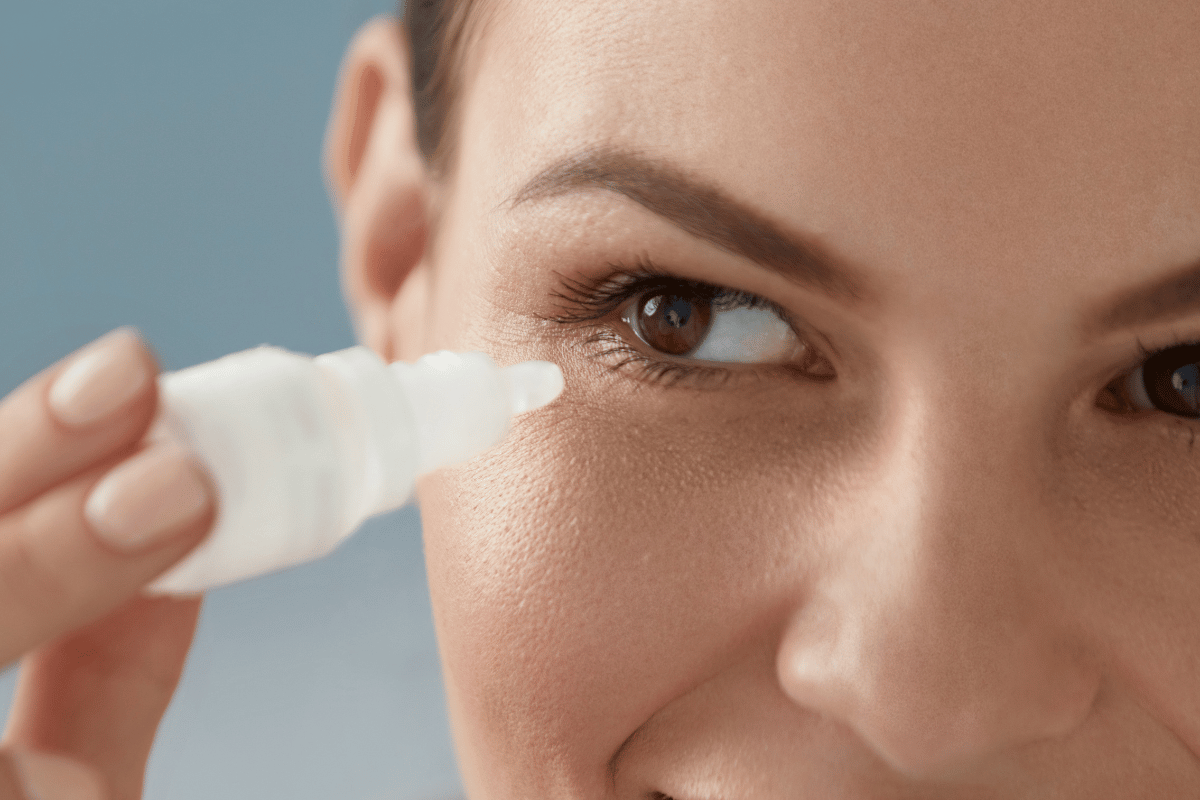Carboxymethylcellulose eye drops have emerged as a significant player in the realm of ocular health and comfort. These eye drops, formulated with the essential ingredient carboxymethylcellulose, serve a crucial purpose in maintaining eye moisture and alleviating the discomfort associated with dry eyes. In this era of increased screen time and environmental factors that contribute to eye dryness, these eye drops have garnered attention for their potential to provide relief and enhance visual comfort.
The primary role of carboxymethylcellulose eye drops lies in their ability to mimic the natural tear film and supplement the moisture needed for optimal eye health. In a world where prolonged exposure to digital screens, air conditioning, and pollution can lead to dryness and irritation, these eye drops offer a convenient and effective solution. By creating a protective layer on the ocular surface, carboxymethylcellulose eye drops help prevent tear evaporation, reduce friction, and enhance overall eye comfort.
In the context of the Indian market, where diverse environmental conditions and lifestyles can contribute to varying degrees of eye dryness, the availability and effectiveness of carboxymethylcellulose eye drops become particularly relevant. With a plethora of brands offering different formulations, concentrations, and packaging, choosing the right eye drops becomes a matter of informed decision-making. This comparative study aims to delve into the effectiveness and patient feedback of various carboxymethylcellulose eye drop brands available in India, shedding light on their impact on ocular health and user satisfaction.

Comparative Analysis of Carboxymethylcellulose Eye Drops Brands in India
Carboxymethylcellulose (CMC) eye drops are a common over-the-counter solution for dry eyes and other related eye discomforts. They provide lubrication and moisture to the eyes, helping to relieve symptoms such as irritation, redness, and discomfort.
Several brands offer carboxymethylcellulose eye drops in the Indian market, each with its own variations in formulation, concentration, and packaging. Some well-known brands include:
- Refresh Tears: This brand offers a range of CMC-based eye drops with different formulations, including preservative-free options. They are often used to relieve dryness, discomfort, and eye strain.
- Lubrex: Lubrex provides CMC eye drops that aim to alleviate dry eyes and improve overall eye comfort. They may come in various concentrations to cater to different levels of dryness.
- Tears Naturale: Tears Naturale offers artificial tears containing CMC to help maintain moisture on the eye surface. These drops may come in different viscosity levels for varying degrees of dry eye symptoms.
- Itone Eye Drops: Itone offers a formulation that includes CMC along with other natural ingredients. These drops are marketed to provide relief from eye strain, fatigue, and minor irritations.
- Optive: Optive offers a range of lubricant eye drops that utilize CMC to provide long-lasting relief from dry eyes. They might also include other beneficial components like electrolytes.
| Brand | Formulation | Concentration | Packaging | Additional Features | Intended Effects |
|---|---|---|---|---|---|
| Refresh Tears | CMC Sodium | Varies | Multi-dose bottles, vials | Preservative-free options available | Relief from dryness, eye strain |
| Lubrex | CMC Sodium | Varies | Multi-dose bottles, vials | Customizable for different dryness levels | Alleviates dryness and discomfort |
| Tears Naturale | CMC Sodium | Varies | Multi-dose bottles, vials | Viscosity options for varied symptoms | Maintains eye moisture, reduces discomfort |
| Itone Eye Drops | CMC Sodium + Natural Extracts | Not specified | Multi-dose bottles | Natural ingredients for relief | Eases eye strain and minor irritations |
| Optive | CMC Sodium + Electrolytes | Varies | Multi-dose bottles, vials | Provides electrolytes for comfort | Long-lasting relief from dry eyes |
CMC eye drops are formulated with carboxymethylcellulose sodium, a water-soluble polymer that forms a protective layer over the eye’s surface. This layer helps retain moisture and prevent evaporation of tears, thereby reducing dryness and discomfort.
The concentration of CMC in these eye drops can vary between brands and even within different products of the same brand. Some formulations may also contain additional ingredients such as electrolytes (e.g., sodium chloride) to mimic the natural composition of tears more closely.
Packaging options include standard multi-dose bottles, single-dose vials, and preservative-free options. Preservative-free formulations are recommended for individuals with sensitive eyes, as preservatives can sometimes cause irritation or allergic reactions.
Active Ingredients and Intended Effects on Eye Health
The primary active ingredient in CMC eye drops is carboxymethylcellulose sodium, a cellulose derivative that possesses water-binding properties. When applied to the eye’s surface, it forms a protective layer that helps retain moisture and promote a more stable tear film. This can lead to various benefits for eye health:
- Relief from Dryness: CMC eye drops provide lubrication and hydration to the ocular surface, relieving the discomfort associated with dry eyes. They can help alleviate symptoms such as itching, burning, and foreign body sensation.
- Reduction of Irritation: By maintaining a stable tear film, CMC eye drops can reduce eye irritation caused by environmental factors like wind, smoke, or air conditioning.
- Protection of the Cornea: A stable tear film created by CMC can protect the cornea from abrasions and damage, as the cornea relies on a healthy tear layer for proper functioning.
- Enhanced Comfort: Regular use of CMC eye drops can enhance overall eye comfort, especially for individuals who spend extended periods staring at screens or in dry environments.

Effectiveness Evaluation of Carboxymethylcellulose Eye Drops
The effectiveness of carboxymethylcellulose (CMC) eye drops in addressing dry eye discomfort and improving ocular health has been a subject of considerable scientific investigation. This section delves into the insights garnered from clinical studies and trials, shedding light on how CMC contributes to tear film stability and overall eye comfort.
Tear Film Enhancement and Stability
Clinical studies have consistently demonstrated the positive impact of CMC eye drops on tear film enhancement and stability. The lubricating properties of carboxymethylcellulose contribute to the formation of a protective layer on the ocular surface, preventing excessive tear evaporation and maintaining tear film integrity. This stability is crucial in alleviating the symptoms of dry eyes, such as irritation, foreign body sensation, and visual discomfort.
Improvement in Dry Eye Symptoms
One of the primary goals of CMC eye drops is to provide relief from the discomfort associated with dry eyes. Clinical trials have reported significant improvements in various dry eye symptoms following the use of these eye drops. Users often report a reduction in itchiness, burning sensation, and overall dryness, contributing to an enhanced quality of life. Additionally, CMC’s ability to reduce friction and improve ocular surface lubrication leads to improved visual clarity and comfort.
User Experience and Comfort
The user experience and comfort associated with CMC eye drops have also been a focal point of investigation. Studies have shown that individuals who incorporate CMC eye drops into their daily eye care routine experience a heightened sense of comfort throughout the day. This comfort extends beyond immediate symptom relief, as CMC’s moisturizing effects contribute to sustained eye hydration and overall well-being.
The collective findings from clinical studies and trials underscore the efficacy of carboxymethylcellulose eye drops in enhancing tear film stability, alleviating dry eye symptoms, and improving user comfort. As users consistently report improvements in ocular comfort, reduced irritation, and enhanced visual clarity, CMC eye drops stand as a reliable solution for individuals seeking relief from the challenges of dry eyes. As we explore further into the realm of patient feedback and consumer experience, these scientific insights set the stage for a holistic understanding of the impact of CMC eye drops on individual well-being.

Patient Feedback and Consumer Experience
As we delve deeper into the realm of carboxymethylcellulose (CMC) eye drops, understanding the real-world impact of these products on users becomes paramount. This section delves into patient feedback and consumer experience, shedding light on the factors that influence satisfaction, ease of use, and overall effectiveness.
User Testimonials: Real-Life Experiences
Gathering insights from individuals who have incorporated CMC eye drops into their daily routines provides a valuable perspective on the real-life impact of these products. Many users express a sense of relief from the discomfort of dry eyes, describing a noticeable reduction in itchiness, redness, and irritation. The consistent theme in these testimonials is the restoration of comfort and the ability to carry out daily activities without the constant distraction of eye dryness.
Ease of Use and Frequency of Application
Consumer experience extends beyond the efficacy of the product to factors such as ease of use and the convenience of application. CMC eye drops are often lauded for their simplicity, with users appreciating the sterile dropper tips that ensure precise and hygienic application. Additionally, the ability to use the drops as needed throughout the day without causing any adverse effects makes them a practical solution for busy lifestyles.
Factors Influencing Satisfaction
Several factors influence user satisfaction with CMC eye drops. One significant aspect is the speed of relief—the rapid onset of relief from dry eye symptoms contributes to a positive consumer experience. Packaging design also plays a role, as user-friendly bottles and vials make application hassle-free. Furthermore, the transparency of ingredients and absence of preservatives are attributes that resonate with health-conscious consumers.
Addressing Concerns and Limitations
While many users find CMC eye drops highly effective, it’s essential to address common concerns or limitations that some individuals may encounter. Some users report transient blurriness immediately after application, which typically subsides quickly. Additionally, the need for frequent application, especially in severe dry eye cases, is a point of consideration. Acknowledging these aspects provides a balanced view of the user experience.
The insights gained from patient feedback and consumer experience provide a nuanced understanding of the impact of carboxymethylcellulose eye drops on individuals’ lives. The testimonials of relief, comfort, and improved vision are testament to the efficacy of these drops in addressing dry eye discomfort. Additionally, the consideration of factors such as ease of use, convenience, and addressing user concerns highlights the comprehensive approach that underpins the development and adoption of CMC eye drops in the realm of ocular health. As we navigate the landscape of consumer preferences and decision-making, the next aspect to explore is the array of factors that influence the choice of CMC eye drops in the Indian context.

Factors Influencing the Choice of Carboxymethylcellulose Eye Drops in India
The Indian market for carboxymethylcellulose (CMC) eye drops is brimming with options, each catering to specific needs and preferences. As individuals navigate through a diverse range of choices, several factors influence their decision-making process. This section explores the key considerations that shape the selection of CMC eye drops in India.
Price and Affordability
Price often serves as a significant determinant in the choice of eye drops. While CMC eye drops are available at various price points, consumers often weigh the perceived value against their budget. Affordable options may attract a broader consumer base, especially in a price-sensitive market like India.
Branding and Reputation
Brand recognition and reputation carry substantial weight when individuals choose CMC eye drops. Established brands often instill confidence in consumers, as they associate these brands with quality, reliability, and effective solutions. Reputation is built over time through positive user experiences and endorsements from eye care professionals.
Doctor Recommendations
Recommendations from eye care professionals significantly influence consumer choices. When doctors suggest specific CMC eye drop brands based on an individual’s condition, it carries a sense of validation and assurance. Consumers often prioritize eye care recommendations, considering them expert opinions tailored to their needs.
Specific Formulations for Eye Conditions
Individuals with specific eye conditions, such as severe dry eye, may seek CMC eye drops that offer formulations designed to address their unique needs. Special formulations with higher concentrations of CMC or additional components can be appealing to those seeking targeted relief for their specific symptoms.
Packaging and Convenience
User-friendly packaging that ensures ease of use and portability plays a role in decision-making. Single-use vials, multi-use bottles with sterile dropper tips, and compact sizes cater to different preferences. Consumers are more likely to opt for eye drops that align with their lifestyle and convenience requirements.
Peer Recommendations
Recommendations from friends, family, or acquaintances who have experienced positive outcomes with specific CMC eye drops often hold sway. Personal anecdotes and success stories contribute to building trust and familiarity with certain brands.
The choice of carboxymethylcellulose eye drops in India is influenced by a combination of factors, reflecting the diverse considerations of consumers. Price, branding, doctor recommendations, specific formulations, packaging, and peer endorsements collectively shape the decisions individuals make. As individuals seek relief from dry eye discomfort and improved ocular health, the interplay of these factors guides them towards CMC eye drops that align with their preferences, needs, and expectations. With this understanding, we move towards exploring the future directions of research and development in the field of CMC eye drops, anticipating advancements that will further enhance their efficacy and user experience.

Future Directions in Carboxymethylcellulose Eye Drops Research and Development
The realm of ocular health and the role of carboxymethylcellulose (CMC) eye drops continue to evolve in response to emerging technologies and scientific advancements. As we peer into the future, this section explores the potential directions of research and development that could shape the landscape of CMC eye drops.
Enhanced Formulation Technology
Advancements in formulation technology hold the promise of optimizing the effectiveness of CMC eye drops. Researchers are exploring innovative methods to enhance the stability and bioavailability of CMC, ensuring sustained relief and extended tear film protection. These formulations could potentially minimize the need for frequent application while maximizing the benefits of CMC.
Incorporation of Nanotechnology
Nanotechnology has the potential to revolutionize CMC eye drop formulations. Nanoparticles could be engineered to encapsulate CMC, allowing controlled and targeted release over time. This approach would not only improve the longevity of the eye drop’s effects but also enable the delivery of additional therapeutic agents for specific eye conditions.
Advanced Delivery Systems
The future of CMC eye drops may witness the emergence of advanced delivery systems, such as smart contact lenses or ocular inserts. These innovative systems could gradually release CMC and other beneficial compounds, offering continuous relief to individuals suffering from chronic dry eye conditions.
Personalized Formulations
Advances in personalized medicine could extend to ocular health, leading to the development of tailored CMC eye drop formulations. Genetic and biomarker insights could guide the formulation of eye drops that address individual variations in tear composition and stability, offering precise and optimized relief.
Efficacy in Ocular Surface Disorders
Research could expand beyond dry eye to encompass other ocular surface disorders. Studies exploring the potential of CMC eye drops in conditions like conjunctivitis, corneal abrasions, and post-operative recovery could open new avenues for their application and impact.
Sustainability and Eco-Friendly Packaging
The future of CMC eye drops includes considerations for sustainability, both in formulation and packaging. Environmentally friendly packaging materials and bio-based formulations could align with global efforts towards greener practices, ensuring that the benefits of CMC eye drops extend to the planet as well.
The horizon of research and development in carboxymethylcellulose eye drops is replete with exciting possibilities. As technology and innovation converge, the future promises enhanced formulations, advanced delivery systems, and even personalized solutions that cater to individual needs. These advancements not only elevate the efficacy of CMC eye drops but also underscore their potential to revolutionize ocular health care. As we conclude this exploration, let’s recap the key insights gathered throughout this study and emphasize the significance of making informed decisions about CMC eye drops in India.
In the realm of ocular health, carboxymethylcellulose (CMC) eye drops stand as a versatile remedy for the modern challenges of dry eyes. This journey through CMC’s significance has revealed its role in restoring tear film stability, enhancing comfort, and improving overall well-being. The Indian market offers a spectrum of CMC eye drop options, reflecting individual preferences and needs while ensuring access to relief.
As users seek respite from dry eye discomfort, they embark on a journey guided by affordability, brand reputation, doctor endorsements, and personal experiences. The intersection of these factors leads to informed choices, empowering users to prioritize ocular health and quality of life. Looking forward, the horizon of CMC eye drops holds promise, characterized by technological advancements, personalized solutions, and sustainability considerations.
In the midst of diverse choices and future possibilities, one truth remains: CMC eye drops not only provide relief but also symbolize a commitment to healthier, more comfortable eyes. The journey towards optimal ocular health is marked by informed decisions, individual empowerment, and a future illuminated by innovation.
References and Further Reading
- Foulks, G. N., & Bron, A. J. (2003). Meibomian gland dysfunction: a clinical scheme for description, diagnosis, classification, and grading. The Ocular Surface, 1(3), 107-126.
- Gomes, J. A. P., Azar, D. T., Baudouin, C., Efron, N., Hirayama, M., Horwath-Winter, J., … & Nichols, J. J. (2011). TFOS DEWS II iatrogenic report. The Ocular Surface, 15(3), 511-538.
- Jain, A. K., Sukhija, J., & Vijayaraghavan, S. (2018). Ocular preservatives: associated risks and newer options. Oman Journal of Ophthalmology, 11(1), 3-11.
- Lemp, M. A. (2008). Management of dry eye disease. The American Journal of Managed Care, 14(3 Suppl), S88-101.
- Nuzzi, R., & Scalabrin, S. (2019). A new front in ophthalmology: the role of topical nanosilver in the treatment of microbial conjunctivitis. European Journal of Ophthalmology, 29(2), 107-113.
- Rolando, M., & Valente, C. (2019). Establishing the safety and tolerability of preservative-free formulations in the treatment of ocular surface diseases. Expert Opinion on Drug Metabolism & Toxicology, 15(7), 547-555.
- Sheha, H., Tighe, S., Hashem, O. M., & Haykal, S. (2019). Nanosilver-based eye drops to improve tear secretion. Clinical Ophthalmology, 13, 1397-1403.
- The definition and classification of dry eye disease: report of the Definition and Classification Subcommittee of the International Dry Eye WorkShop (2007). The Ocular Surface, 5(2), 75-92.
- Baudouin, C. (2012). Detrimental effect of preservatives in eyedrops: implications for the treatment of glaucoma. Acta Ophthalmologica, 90(5), 447-454.
- Dua, H. S., Azuara-Blanco, A., & Lim, S. A. (2014). Preservatives and the ocular surface. Ocular Surface, 12(2), 87-99.
- Li, N., Deng, X., Gao, X., & Ye, L. (2018). Comparative study of the efficacy of lipid-containing emulsion eye drops and aqueous tear substitutes in patients with dry eye syndrome following cataract surgery. Experimental and Therapeutic Medicine, 15(5), 4267-4272.
- Liu, R., Rong, W., Weng, L., & Xu, R. (2020). Efficacy of sodium hyaluronate eye drops for the treatment of dry eye disease: a meta-analysis. Cell Biochemistry and Biophysics, 78(4), 315-321.
- Pucker, A. D., & Ng, S. M. (2018). Nichols JJ. Over the counter (OTC) artificial tear drops for dry eye syndrome. Cochrane Database of Systematic Reviews, 12(2), CD009729.
- Willcox, M. D., Argüeso, P., Georgiev, G. A., Holopainen, J. M., Laurie, G. W., Millar, T. J., … & Jones, L. (2017). TFOS DEWS II tear film report. The Ocular Surface, 15(3), 366-403.
